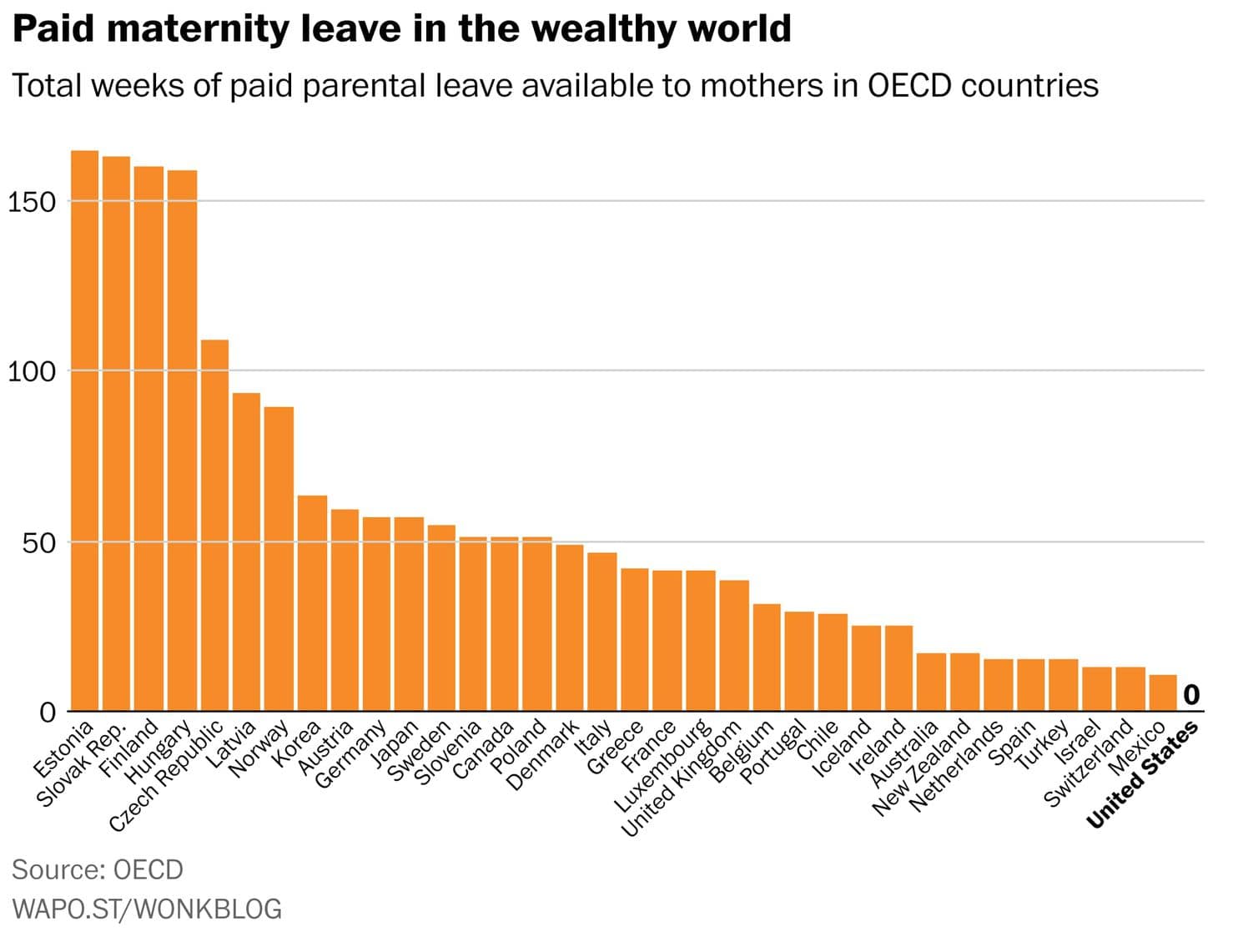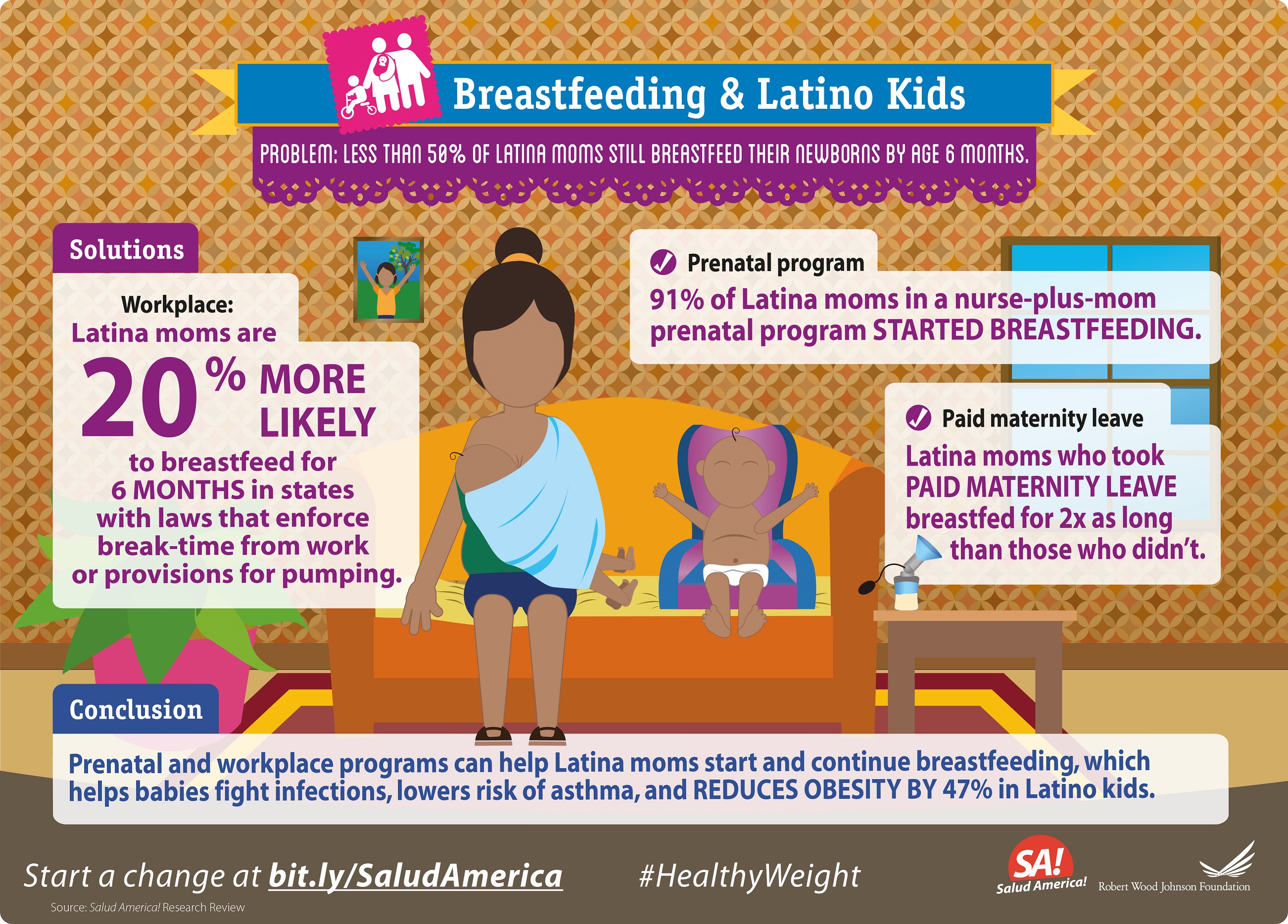
Share On Social!
Paid leave reduces the use of public services, boosts employee productivity, and can help families better succeed—yet three in four Latinos are unable to take such time.
Despite data that shows its benefits, there is no federal requirement to provide paid family leave.
The 1993 federal Family and Medical Leave Act (FMLA), legislation most businesses follow, does not cover all workers and leave offers are unpaid.
Lack of paid leave and other economic support contributes to health and economic disparities among Latinas, Latinos, and low-income families.
Still, paid leave is gaining popular support, including a proposal for universal paid family leave.
“If the [corporate officers and directors] gets paid leave, then the factory floor worker should also get paid leave,” said Sen. Kirsten Gillibrand, who recently reintroduced legislation to provide parents with six months of paid leave.
Paid Leave is a Social Justice Issue
Although an increasing number of children worldwide live in households where both parents are employed, the U.S. is one of only two countries in the world that doesn’t have paid family leave. Additionally, only 25% of Latinos have access to paid family leave through an employer, the lowest rate of any racial or ethnic group.

Latinos have the highest labor force participation rate (66%) of any demographic. However, a significant number work low-wage jobs, which do not provide paid leave or paid family leave, according to the National Partnership for Women & Families’ (NPWF) paid leave fact sheet.
In 2018, 90% of U.S. managers and professionals enjoyed paid sick leave compared to only 56% of service workers and 54% of construction and extraction workers, according to the Bureau of Labor Statistics (BLS). Furthermore, only 23% of employed Latinos work in management or professional occupations, according to another BLS report.
In 2018, the NPWF released an issue brief explaining how paid leave is a racial justice issue, as well as fact sheet explaining how paid leave works.
The Latino community at-large is disproportionately affected by this issue; greater still are the impacts working Latinas face.
Paid Leave is a Gender Equality Issue
Women are most affected by the lack of paid family and medical leave. The labor force loses valuable talent when women are penalized for caring for newborns and aging family members.
Women who take paid leave are 93% more likely to be in the workforce nine to 12 months after a child’s birth than women who take no leave, according to the NPWF.

That same research also shows new mothers in states without paid leave participate in public assistance programs more than twice as often as those living in states with paid leave programs.
Research from California’s state paid leave program, the first in the nation, shows increased parity in the duration of leave taken by Black and white women. Prior to the 2004 policy, Black women averaged one week of leave compared to four weeks for their white peers. After implementation, Black and white mothers both averaged seven weeks of leave.
Studies also illustrate the benefits breastfeeding has on babies. Latina moms who took paid family leave breastfed for two times as long as those who didn’t, according to a Salud America! Research Review.
All parents—mothers and fathers—should be able to take time from work to care for their family without jeopardizing their paycheck or job.
Paid Leave Benefits Families
Working families lose an estimated $20.6 billion in wages each year due to lack of access to paid family leave.

Paid leave also reduces the use of public assistance, like the Supplemental Nutrition Assistance Program (SNAP) and Medicaid and increases use of preventive health care services.
“It’s helping people reduce burdens when it comes to people balancing their work and family lives, because that is in essence what people’s lives are all about,” said “Betsey Stevenson, a member of the Council of Economic Advisers and an economics and public policy professor at the University of Michigan, told The New York Times.
Fathers who use paid leave are more confident and involved in caring for their children, according to the Administering Paid Family and Medical Leave report. The benefits of breastfeeding and father involvement continue long after paid leave ends, through childhood and into adulthood.
Paid Leave Works for Business
Pro-work policies, like paid family leave, can benefit low- and middle-income families without imposing a cost on businesses, all the while improving income stability and higher labor force attachment.
Of 253 employers affected by California’s 2004 paid family leave initiative over 90% reported either positive or no noticeable effect on profitability, turnover, and morale, according to a 2014 report from The Council of Economic Advisers.
A more recent survey of California employers revealed that 87% confirmed that the state program had not resulted in any increased costs, according to the NPWF.
Companies also lose time and money hiring new workers.
Employers spend roughly 20% of a worker’s salary on hiring a replacement, according to the Administering Paid Family and Medical Leave report from the Center for American Progress.
There are broad social and economic costs when employers don’t allow Medicaid recipients to take time off for preventive care services and give parents the opportunity to be with their newborn or sick child.
PL + US created a toolkit of resources to help workplaces achieve a quality paid family leave policy.
Paid Leave Opportunities
In January 2019, California lawmakers introduced new legislation to provide parents with six months of paid leave. Since then, five states and Washington D.C. have passed legislation requiring paid family leave.
Last week, New Jersey became one of those states to sign such a bill into law.
“I’ll sign into law sweeping legislation expanding paid family leave, a huge win for working families and our economy,” New Jersey Gov. Phil Murphy tweeted. “No one should have to choose between earning a paycheck and spending time with a newborn child or caring for an ailing relative.”
At the federal level, lawmakers from both parties have expressed a desire to implement family paid leave legislation.
“The Trump Administration is committed to working with Congress to enact a working family agenda, including policies that would extend paid family leave to more American workers,” according to the February 2018 Economic Report of the President.
However, if paid family and medical leave programs are not crafted to meet the needs of Latino families, they can disproportionately exclude these families and worsen economic and health challenges, according to an issue brief from the NPWF.
Some companies, such as The Gates Foundation, are filling in the gap by providing paid parental leave. They offer six months paid leave for parents and a $20,000 stipend when they return for child care costs.
Still, many of the nation’s most vulnerable families are left choosing between work and family. That’s why, in January 2019, California lawmakers introduced new legislation to provide parents with six months of paid leave.
That’s also why UnidosUS is partnering with representatives and advocates, including Gillibrand, to reintroduce the FAMILY Act. The FAMILY Act would guarantee 12 weeks of partially paid leave for new parents and those caring for a sick relative and enable workers to earn 66% of their monthly wages. This bill would cover workers in all companies.
With the National Partnership for Women & Families, UnidosUS released one national and six state fact sheets exploring the impact of paid family and medical leave.
According to the Fact Sheets:
- 44,485 Latino Workers in Alabama Would Benefit from the FAMILY Act
- 580,188 Latino Workers in Arizona Would Benefit from the FAMILY Act
- 2 Million Latino Workers in California Would Benefit from the FAMILY Act
- 199,581 Latino Workers in Nevada Would Benefit from the FAMILY Act
- 3 Million Latino Workers in Texas Would Benefit from the FAMILY Act
- 242,885 Latino Workers in Virginia Would Benefit from the FAMILY Act
Let’s raise awareness about paid family and medical leave for Women’s History Month!
By The Numbers
142
Percent
Expected rise in Latino cancer cases in coming years



